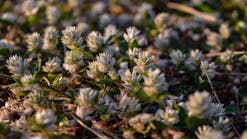The National Oceanic and Atmospheric Administration (NOAA) announced $18.9 million in funding for harmful algal bloom (HAB) research projects and monitoring activities throughout U.S. coastal and Great Lakes waters.
NOAA is announcing $18.9 million in funding for harmful algal bloom (HAB) research projects and monitoring activities throughout U.S. coastal and Great Lakes waters.
Marine and fresh waters of the U.S. are increasingly impacted by HABs, with blooms reported in every state. They cost the U.S. economy millions of dollars each year, and costs from a single major HAB event can reach tens of millions of dollars.
The administration says that the investments in these projects represent a coordinated effort between NOAA’s National Centers for Coastal Ocean Science (NCCOS) and the U.S. Integrated Ocean Observing System (IOOS) Office within NOAA’s National Ocean Service to advance the nation's ability to observe, monitor, forecast and manage blooms. NOAA's Ocean Acidification Program (OAP), under NOAA’s Office of Oceanic and Atmospheric Research, has also partnered with NCCOS to advance understanding of interactions between acidification and HABs in coastal waters and the Great Lakes.
“Harmful algal blooms and ocean acidification are two issues that impact coastal resources and we need to understand how they interact,” said David Kidwell, director of NOAA’s NCCOS Competitive Research Program. “In addition to better detection methods, we want to continue the development of technologies for controlling HABs, and enhance and improve our forecasting and monitoring abilities. These grants will help with those goals.”
NCCOS allocated $16.1 million to fund harmful algal bloom research in fiscal year 2022, including $3.3 million for six new research awards, $10.4 million for 23 continuing awards and $2.4 million for two Community-Directed Spending projects. Four of the new competitive research awards are funded in partnership with NOAA’s OAP. Funded projects will determine interactions between HABs and ocean acidification; establish a U.S. Harmful Algal Bloom Control Technology Incubator; enhance detection of toxins and improve forecasts; and investigate the social and economic impacts of harmful algae.
A full list of the new NOAA NCCOS grant awards is available online.
The U.S. IOOS Office has allocated $2.8 million in fiscal year 2022 for pilot projects for the nascent National Harmful Algal Bloom Observing Network and a related Ocean Technology Transition project. Those funds will be distributed across all 11 IOOS Regional Associations for three new and eight continuing projects to enhance the nation’s capacity for monitoring and detection of harmful algal blooms.
The new IOOS HAB projects will focus on expanding and improving HAB observations and testing capabilities; community coordination and service delivery for stakeholders; improving and optimizing HAB forecasts; testing new technology for the detection of HABs; and funding ongoing operation and maintenance of the HAB testbed and existing infrastructure.
“We will continue to enhance our network’s capacity to monitor and detect these blooms using our expertise across regions,” said Carl Gouldman, director of the U.S. IOOS Office. “We want to push out even further and provide complete end-to-end HAB detection and monitoring systems. These efforts provide critical decision support nationwide using the best data available.”
A full list of the new IOOS grant awards can be found online.






